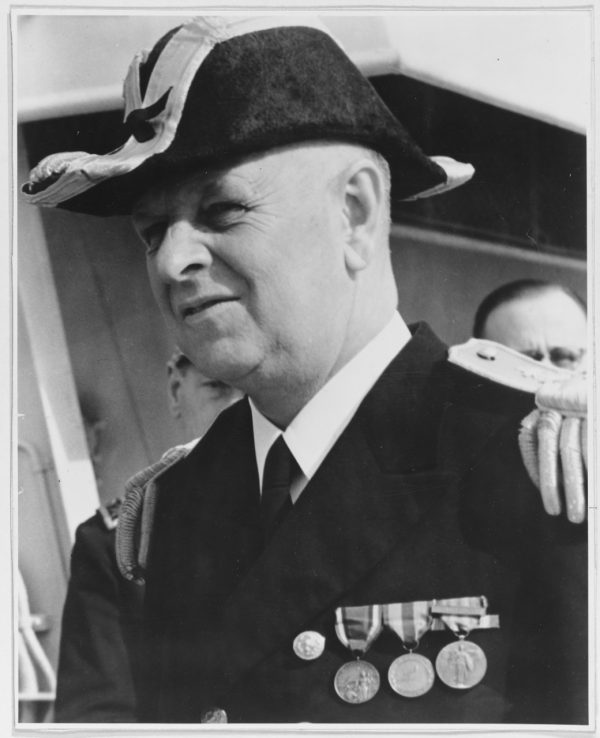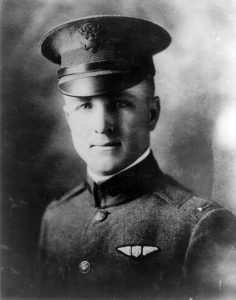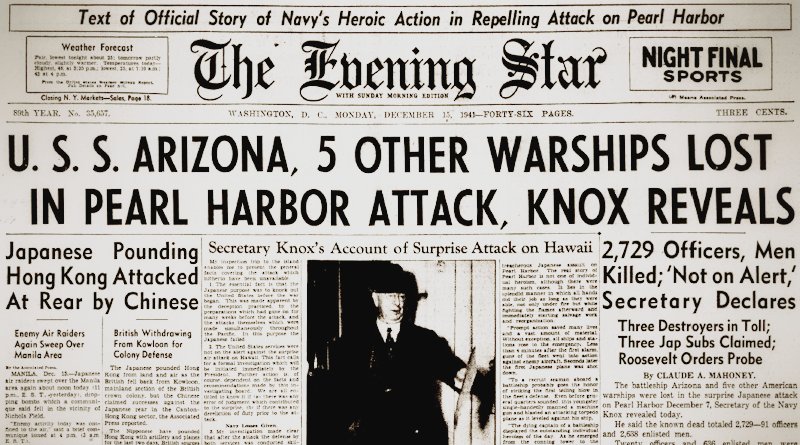World War II Chronicle: December 15, 1941
Click here for TODAY’S NEWSPAPER
Navy Secretary Frank Knox has returned from his inspection of Pearl Harbor, and the front page details some of what he is willing to discuss so far (see this communique for more). Commanders like Adm. Husband E. Kimmel1Kimmel, U.S. Naval Academy, Class of ’04, sailed with the Great White Fleet and was wounded during the Occupation of Veracruz before serving as a gunnery officer during the First World War. He also served as an aide to Assistant Secretary of the Navy, Franklin D. Roosevelt. Named Commander-in-Chief of both the U.S. Fleet (CINCUS) and the Pacific Fleet (CINCPAC) on Feb. 1, 1941. His father Manning M. Kimmel is one of just four West Point graduates to fight for both the Union and the Confederacy during the Civil War. are about to be replaced. It is understandable that, looking back a week after our Pacific Fleet Headquarters was devastated, the American public wanted accountability.

But Dec. 7, 1941 could have gone far, far worse. In fact, given the intelligence the Army and Navy had at the time, it may even be reasonable to assume that anyone else in command of the Pacific Fleet or its defenses would have carried out their duties similarly, and that negligence wasn’t the problem. Although they were operating under ambiguous war-like conditions, prior to Dec. 7, the United States was technically at peace. A forward-thinking commander on U.S. territory can’t arbitrarily decide to have air defense artillery locked and loaded and armed planes on standby; a lot of laws, policy, and logistics stand in your way (the U.S. military is — and was — a massive bureaucracy). The Navy and War Departments were aware that a Japanese strike was possible — perhaps as early as the closing days of November 1941 — they certainly didn’t know when or where.
The Imperial Japanese Navy owed much of its success to the fact that attacking Oahu was strategically unsound. Doing exactly what the enemy least suspects is typically good military doctrine — unless they don’t expect such an attack because it won’t work. Japan’s previous strategy of grinding down the American Navy as we fought our way west would have been far more effective than the path they set in motion on Dec. 7. All they did was to buy time to conquer vast swaths of the Pacific, but several of our sunken ships were repaired, and many more were being produced. Planes and facilities are easily replaced. Loss of life was substantially lower in the shallow harbor waters than if our task forces were attacked at sea.
Maybe it is a bit narcissistic to conclude that the enemy succeeded due to a failure on our end. The Japanese crossed thousands of miles of ocean through horrific weather under radio silence, conducted a refueling at sea, tricked our cryptoanalysts, then successfully navigated to a point where our patrol aircraft wouldn’t detect them, and launched hundreds of warplanes to attack targets at the time that they would be most vulnerable. Yes, it was a sneak attack, but it was brilliantly executed.
While Washington looks for scapegoats, consider that politicians and bureaucrats can easily point fingers at Army and Navy officials who aren’t allowed to publicly defend themselves or reciprocate. What if Adm. Kimmel was sacrificed2Adm. Ernest J. King was offered the job of CINCUS on this day. He accepts. as a smokescreen so the public wouldn’t lose confidence in the Roosevelt administration? And why was Gen. Douglas MacArthur (whose command wasn’t caught totally by surprise) not only escaped scrutiny, but was elevated to national hero status…

Page three announces that 2nd Lt. George S. Welch’s impressive one-day tally of four enemy kills on Dec. 7 is surpassed only by 2nd Lt. Frank Luke Jr.’s total of three enemy planes and two balloons on Sept. 17, 1918. Luke (the namesake of Arizona’s Luke Air Force Base) did not survive the war, but with 18 kills he was second only to Eddie Rickenbacker (26) in U.S. aerial victories. 3Two Americans finished higher than Luke but they flew for the Royal Air Force (RAF). William C. Lambert tied Luke’s 18 kills as an RAF pilot and serves in the U.S. Army Air Force (AAF) as an engineer during the second world war. Wilfred Beaver (19 RAF kills) became an American citizen after the Great War and would serve as executive officer and commander of the AAF’s 447th Bombardment Group during the second world war. Before joining Britain’s Royal Flying Corps (which became the RAF in 1918) Beaver fought for two years with the Canadian field artillery.
A post-war study was able to confirm the two enemies Taylor thought were probable kills, meaning both he and Welch shot down four Japanese warplanes. Their feat is even more impressive when you consider it was their first-ever combat mission, that they only had .30-cal machineguns during their first sortie, they had to takeoff while under attack, and needed to evade “friendly” anti-aircraft fire 4Several American planes were downed by nervous U.S. anti-aircraft gunners on Dec. 7. — all while still wearing their fancy “mess dress” uniforms from last night.
A few pilots were also able to get airborne, like 2nd Lt. Francis “Gabby” S. Gabreski of the 45th Pursuit Squadron, who searched for Japanese warplanes in one of the undamaged planes ground crews could find at Wheeler Field — an obsolete Boeing P-26 “Peashooter” — but by then the Japanese had returned to their flattops. Gabreski will ultimately become the American “Ace of Aces,” with 28 aerial victories during World War II. He then becomes one of seven American pilots to earn ace in two wars, shooting down 5.5 in Korea…
While it is not mentioned in the Star, German long-range coast artillery have targeted the Dover area. The Germans installed a number of coastal defense batteries (originally intended for battleships) along the Dover Strait (just over 20 miles at its narrowest point), featuring cannons ranging from 8.3-inch to the 16-inch “Adolf cannon” which at this point of the war were about to be shipped over from Poland. An Adolf Cannon could fire a 1,300-lb. long-range projectile, cleverly named the “Adolf shell,” that could hit targets 75 miles away…
Sports section begins on page 15, which reports that Pacific Coast champion Oregon State Beavers will be traveling to North Carolina instead of Pasadena, Calif. to play the Rose Bowl. Army blackout restrictions also mean that the East-West Game can’t be played at San Francisco’s Kezar Stadium either… Meanwhile, George Halas’ Chicago Bears defeated Curly Lambeau’s Green Bay Packers in the National Football League’s first-ever divisional playoff game. The Bears and Packers each had a 10-1 record in the 1941 season, the Bears’ only loss to the Packers, and the Packers’ only loss was the Bears (they played twice). The “Monsters of the Midway” will face the New York Giants next Sunday at Wrigley Field for the NFL Championship… Maj. Gen. Henry A. “Hap” Arnold will be pinning in his third star, and Col. Theodore Roosevelt Jr., son of the former president, is being promoted to brigadier general (see page 30).
Evening star. (Washington, D.C.), 15 December 1941. Chronicling America: Historic American Newspapers. Lib. of Congress.
https://chroniclingamerica.loc.gov/lccn/sn83045462/1941-12-15/ed-1/
